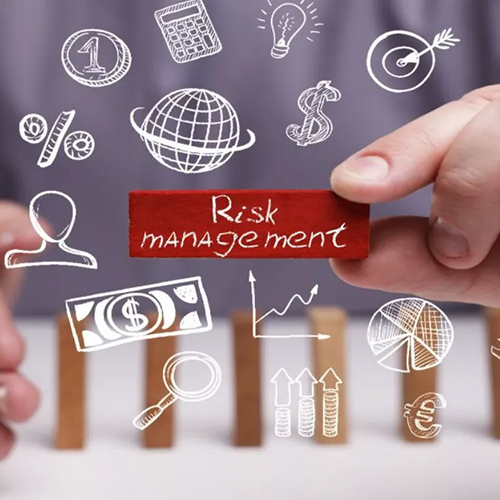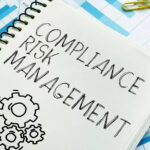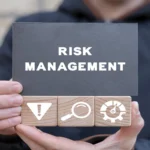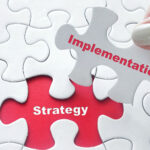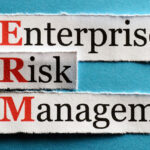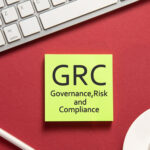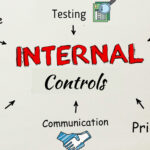In this blog, we explore Enterprise Risk Management (ERM) in banking, emphasizing its strategic, holistic approach to identifying and mitigating risks. We discuss the framework’s benefits, including regulatory compliance, profitability, and operational efficiency. Learn how Anaptyss's Digital Knowledge Operations™ can enhance your ERM practices for a robust risk management strategy.
Enterprise Risk Management (ERM) in the banking industry refers to risk management strategies and systems to identify, manage, and prepare for the potential financial, operational, and event risks that can harm or interfere with operations, short-term or long-term goals, and lead to losses.
ERM is a top-down approach that looks at risks – strategically and holistically – for a bank or financial institution. It enables institutions to develop and incorporate a consistent risk-based approach (RBA) to managing risks across the organization. ERM’s goal is to minimize the impact of adverse risk events and protect the organization from the potentially destructive consequences of new and evolving risks.
This guide outlines the types of enterprise risks in banking and the importance of a well-defined ERM practice to support regulatory requirements such as BSA/AML/ CTF compliance, mitigate risks, minimize losses, and improve growth and profitability.
Importance of Enterprise Risk Management
Enterprise risk management entails defining and implementing practices, policies, and frameworks to handle various risks. It helps financial institutions, including banks, lenders, wealth and asset management companies, and others increase their risk-taking capabilities and identify potential risks to prevent losses and damages due to unexpected adverse outcomes.
It also helps increase awareness of business risks, improve readiness for meeting regulatory mandates, and increase operational alignment.
|
Enterprise Risk Management (ERM) |
SCOPE |
Traditional Risk Management (TRM) |
| Considers all types of risks | Isolates different risk types | |
| Focuses on interrelationships between risks | May lack a comprehensive perspective | |
|
INTEGRATION |
||
| Integrates with strategic planning | Operates in separate silos | |
| Aligns risk with strategic goals | Fragmented approach | |
|
RISK CULTURE |
||
| Views risk as a shared responsibility | Delegates risk management | |
| Fosters a risk-aware culture | Less emphasis on a risk-aware culture |
|
REPORTING AND COMMUNICATION |
||
| Effective communication and reporting | Relies on individual risk reports | |
| Provides a holistic view of risks | Focuses on specific risk categories | |
|
STRATEGIC ALIGNMENT |
||
| Aligns risk with strategic objectives | No explicit linkage to strategic objectives | |
| Strategizes risk management |
Focuses on risk mitigation
|
Benefits of Enterprise Risk Management in Banking
Enterprise risk management can help banks and other financial institutions in various ways, such as:
1. Meet Compliance
Financial institutions are tightly regulated and must comply with various global regulatory requirements to avoid penalties, operational, and reputational risks. By implementing a tailored enterprise risk management process, financial institutions can maintain regulatory compliance and prevent operational disruptions and penalties.
2. Increase Profitability
Financial institutions are also exposed to numerous risks that can lead to monetary losses. An effective ERM can help institutions identify potential risks in advance and manage them proactively to prevent losses. It can also help institutions avoid overspending in fixing problems that can be prevented with effective ERM.
3. Safeguard Reputation
Reputation is everything in the business. A robust ERM can help financial institutions safeguard their reputation and protect customer data, promote trust among the customers, and avoid penalties from the regulators.
4. Improve Customer and Employee Satisfaction
Assessing the risks associated with any new initiatives in the company is critical to operating efficiently. By ensuring strong enterprise risk management processes, banks can build customer trust over time and increase business prospects. An effective ERM plan also helps engage employees in the organization, leading to better results, sustainable growth, more customers, and improved customer satisfaction.
5 Improve Operational Efficiency
With a proactive approach to risk management, financial institutions or the banking industry can improve their resource usage and avoid costly outcomes of unexpected events. ERM helps them respond effectively in the event of a crisis when they occur, minimize the disruption, and restore operations as quickly as possible.
6. Meet Strategic Goals
Strategic aims are important for any organization for sustainable growth that may get derailed due to risks posed by internal or external threats. ERM helps organizations and businesses to have a holistic view of their risk profile and ensure their strategic goals are in scope and objectives are achievable.
7. Focused Risk Analysis and Reporting
ERM helps financial institutions and businesses assess, identify, and report risks proactively and holistically. It also helps bring focus on key risks and reporting for accurate and timely decisions crucial for the organizations to achieve strategic objectives. By focusing on key risks, banks, and financial institutions can effectively allocate resources that can help them make better-informed decisions to manage potential risks, thereby improving transparency and enhancing customer and employee confidence.
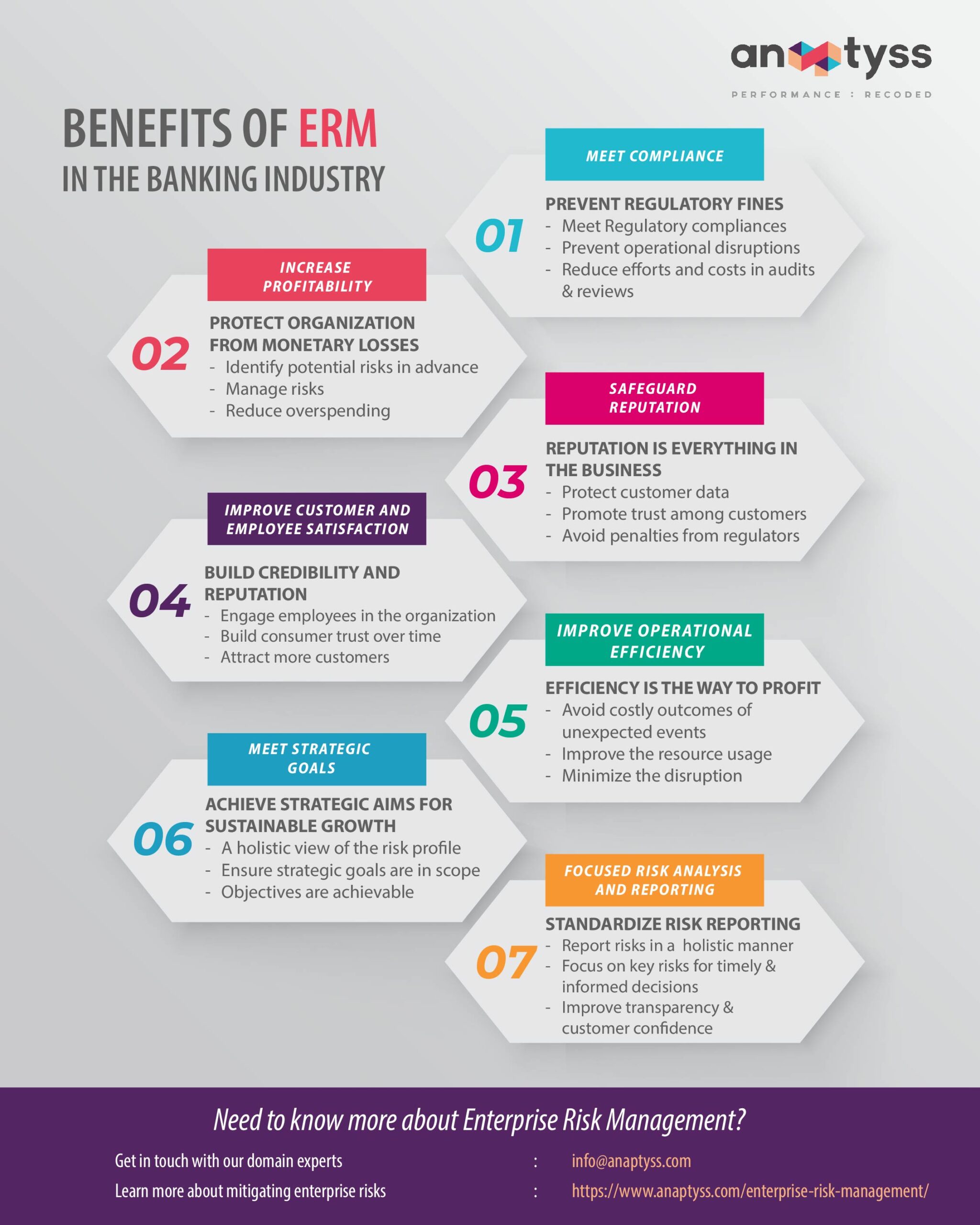
Types of Enterprise Risks in the Banking Industry
Enterprise risks do not come into play when something goes wrong. They always exist throughout the business cycle. Thus, a bank or financial institution must know the nine types of enterprise risks they are exposed to and consider them in their ERM strategy.
1. Financial Risks
Financial risks refer to the financial consequences that may occur due to the inflow and outflow of money in a business and can lead to sudden financial losses. It includes credit risks, market risks, liquidity risks, governance risks, etc.
2. Strategic Risks
Strategic risks arise from contrary business decisions or their adverse implementation, external causes leading to a change in the business decision or the direction of the business.
3. Reputational Risks
Reputational risk refers to a negative impact on the organization’s reputation arising from non-compliance with regulatory norms, losing customers’ data, unethical employee behavior, etc., and leads to business risks or credit downgrade.
4. Operational Risks
Operational risks occur due to internal and external factors, failed or inadequate internal processes, people, systems, or external events. These risks can impact the day-to-day business activities and short-term goals.
5. Compliance Risks
Compliance risks occur due to financial institutions’ inability to meet the laws, rules, regulations, procedures, standards, and financial crime compliances, such as AML, CFT, BSA, Dodd-Frank, USA Patriot Act, etc., damaging the brand credibility.
6. Cybersecurity Risks
Phishing attacks, trojans, ransomware, spoofing, etc., are some of the cybersecurity risks that banks need to deal with to protect customer data from theft, misuse, and unauthorized access, failing which can cause damage to reputation and business.
7. Environmental, Social, and Governance (ESG) Risks
ESG risks are related to organizations’ response to climate change, working and safety conditions, regard for human rights, compliance with the pertaining laws, etc., that can impact reputation, financial position, and operational performance;
8. Hazard Risks
Hazard risks are associated with the health and safety of the customers and employees and include damage to the property due to fire, theft, financial crimes, climatic factors, or from liability, property, or personnel loss exposure.
9. Moral Hazard Risks
Moral hazard risks in banking refer to taking uncommon risks or decisions to maximize profits without any repercussions for risky or bad corporate behavior with little to no regard for moral responsibilities.
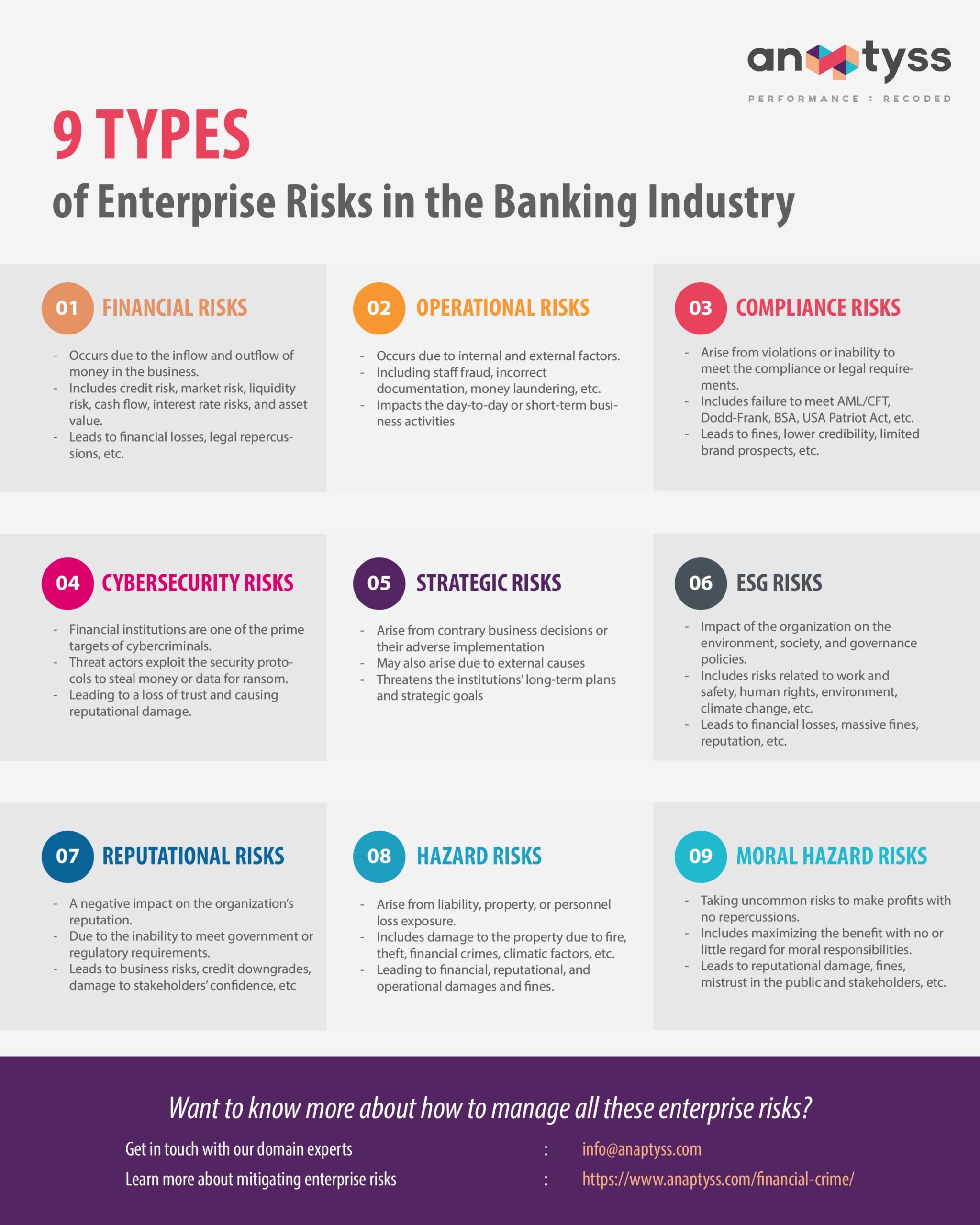
Enterprise Risk Management Framework for Banks
Enterprise risk management framework (ERMF) for banks and financial institutions refers to the set of components that provide the fundamental arrangement for designing, implementing, monitoring, reviewing, and improving risk management at all organizational levels.
It helps financial institutions and organizations identify, analyze, respond to, and control internal and external risks.
Components of Enterprise Risk Management Framework (EMRF) for Banks
A well-designed ERMF can help banks’ boards of directors and senior management determine the amount of risk exposure, their risk appetite, and risk controls. Fundamentally, an ERMF consists of four key components:
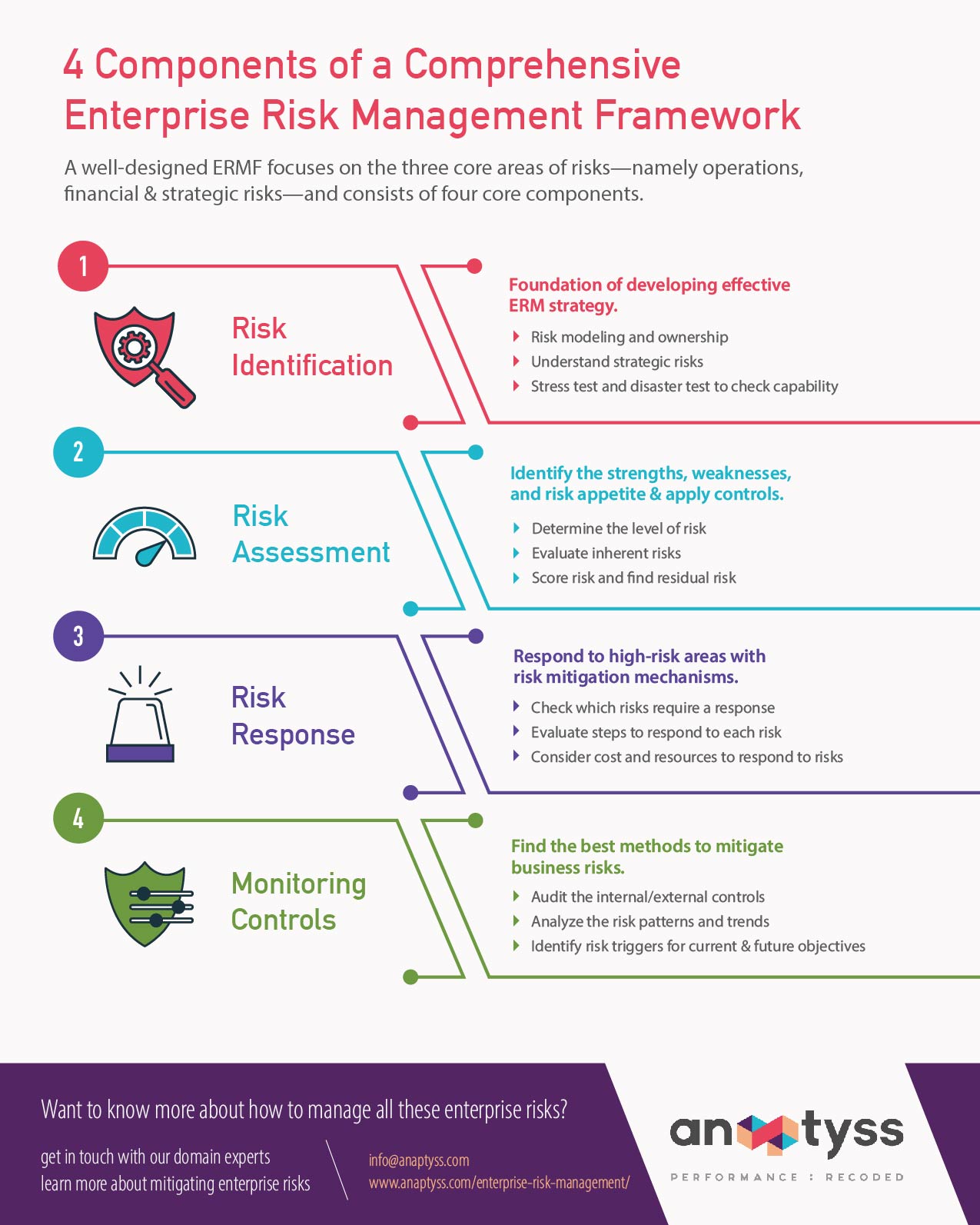
1. Identifying the Areas of Risk
Identifying risks is the foundation of developing an effective and robust enterprise risk management strategy. Banks and financial institutions must review their portfolio to identify or generate a comprehensive list of potential risks and operate from a strategic perspective rather than an operational standpoint. Risk identification involves the following:
a. Risk Modelling
Helps identify areas that require the most attention. These areas are carefully analyzed to understand the risks and their outcomes precisely. This provides an accurate picture of the organization on how it can withstand or handle extremely negative consequences.
b. Risk Ownership
Risk Ownership and management put accountability in place. It is the most effective component of the ERM that includes giving control to the individuals in the organization over the processes. And if something goes wrong, the person or individual is held responsible and may prevent mistakes from turning into bigger issues.
c. Strategic Plan
This refers to understanding the strategic objectives and identifying the risks that can prevent the banks and financial institutions from achieving the organization’s goals or execution of objectives.
d. Stress Test
By performing stress tests, organizations can identify if they have enough capabilities and capital to withstand a financial crisis. This also includes testing the security threats.
e. Disaster Test
The test involves verifying an organization’s capability to withstand and remain stable after a natural or man-made disaster and during war-like situations.
2. Risk Assessment
A robust risk assessment is critical to mitigate losses in the banking and finance industry as it helps determine the level of risk, score risk by analyzing the impact and likelihood or probability of occurrence, and steps to minimize risks within the defined risk appetite of the institute or organization.
Banks need to evaluate the inherent risks posed by error or omission to factors other than failure in the internal control measures. Then quantify the inherent risks by assigning calculated risk scores to the banks’ products, services, customers, and geographical locations. This will help you calculate the residual risk by subtracting the quality of risk management or the impact of risk controls in place from the inherent risk.
Residual risk refers to risks that remain even after implementing the processes and procedures to mitigate or eliminate the high risks associated with the bank’s business processes, systems, customers, geographical locations, and products and services. In risk assessment, considering the residual risks is critical from a regulatory requirements and compliance perspective. It helps you,
- Identify the strengths and weaknesses of the existing control framework and acknowledge existing risks
- Re-verify organizations’ risk appetite
- Implement controls and available options to counter the intolerable residual risks
3. Risk Response
Banks and financial institutions can respond to the areas of high risks with proper controls and risk mitigation mechanisms in place. The purpose is to decide which risks require a response based on the results of risk assessment. By implementing a well-defined risk management strategy, banks can reduce the risk across the organization and counter the threats. Here are some considerations banks need to ensure while responding to the risk:
- Consider the ratings of the risk impact and likelihood you found during the risk assessment.
- Consider your options to respond to the risk, i.e., whether to accept, avoid, mitigate, and/or transfer (outsource to third parties/insurance).
- Evaluate your steps to respond to each risk.
- Consider the cost and resources required to respond to the risk.
- Estimated time to complete the implementation of your response.
4. Monitoring Controls
Monitoring controls and strategies for risk management is critical for checking, supervising, observing, and determining the risk status and finding the best method to mitigate the business risk. It also helps banks identify change from the performance level required or expected and ensure the following:
- Implement the optimal risk response
- Risk responses are effective (risk audits)
- Identify risk triggers for current and future objectives
- Track and validate risk management/control procedures
- Analyze risk patterns and trends
Monitoring controls provide oversight for all the activities performed by internal and external teams or parties that can impact the operations and/or customers. Banks can also form an internal committee or hire an external auditor to review their processes, policies, and procedures to identify and inform the management of enterprise.
Challenges in Building a Customized Enterprise Risk Management Framework
Organizations, including banks and financial institutions, may choose or apply ERM frameworks by industry, such as COBIT, COSO, RIMS, SOC 2 Type 2, ISO 27001, CMMC, and FedRAMP, or use these existing frameworks to build a customized ERM framework depending on the business goals, organization structure, available resources, and technology infrastructure. However, building a customized enterprise risk management framework is a complex task due to the following challenges:
1. Cost
Demonstrating an ERM framework’s value to justify costs in an ROI-driven environment could hamper decision-making. ERM risk and reward metrics are less prescriptive and thus remain voluntary for many organizations, resulting in a value proposition that lacks regulatory language and compliance encouragement.
2. Planning Horizon
The time or planning horizon for an enterprise risk management assessment depends on the organization’s willingness to invest in risk management. Companies often prefer short-term planning horizon as it generally needs less training, is less expensive, and provides risk estimation than long-term ones. For successful ERM objectives, banks and financial institutions must choose a solution consistently.
3. Defining Risks
Establishing a formal risk management framework and commonly applied risk nomenclature are the biggest challenges in developing or implementing a risk management program. Failing to establish a common risk definition or methodologies is likely to jeopardize the program’s success and aggravate the risks faced by the organization.
4. Ownership
Another prominent challenge in building and implementing ERM is the question—of who should own the ERM—which is often disputed and unclear at the board, director, audit committee, and management levels.
5. Risk Reporting
Organizations often find it challenging to answer what information to share with internal or external constituents and how to communicate the risk. Also, protecting sensitive information by hiding the specifics while providing risk insights is critical to avoid company lawyers raising the issues to external regulators, constituents, and auditors.
Suggested Read: 4 Key ERM Frameworks to Manage Cybersecurity Risks in Banking
Enterprise Risk Management – Role of Data and Automation
Effective risk management and regulatory compliance have a great deal to do with ‘data’. Given the proliferation of data and its influence on decision-making, organizations, including financial institutions, must harness their data assets to draw insights.
Automation is also key to enhancing enterprise risk management processes and ensuring data integrity, tracking gaps, and tasks, and making the required information readily available for decision-making. With the implementation of intelligent digital solutions and automation powered by AI and ML, banks can manage their vast data efficiently, understand risks, and meet compliance in an autonomous manner.
Develop Robust Enterprise Risk Management Framework with DKO™
The lack of expertise to efficiently manage or counter the various business risks and threats could be a major decision-maker for investors, customers, and employees. Before implementing the enterprise risk management strategy, it’s critical to identify potential risks. However, keeping pace with the ever-changing risk landscape could be challenging for many banks and financial institutions as they face unique challenges that other businesses don’t.
As a strategic partner, Anaptyss provides a consultative, data-driven, and tailored approach powered by its exclusive Digital Knowledge Operations™ (DKO™) framework to banks and financial institutions in implementing intelligent digital solutions appropriate for the organization’s size, and complexity level, and important to keep the business safe from critical enterprise risks across all levels.
Interested in more specific guidance for Enterprise Risk Management in the banking industry? Write to us: info@anaptyss.com.

